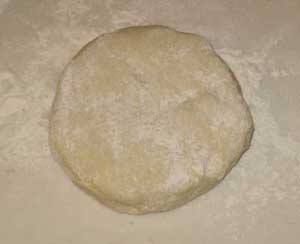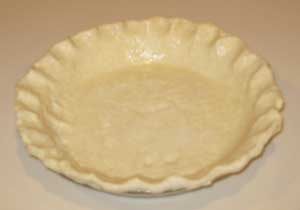Butter Crust Pie Shell
Everyone has a recipe for pie crust and they're mostly all alike: flour and fat, either shortening or butter. This one uses butter and may be worth reading for comments on technique. This is based on a recipe by J. Kenji López-Alt, who developed the technique of using a butter-flour paste. My revision fixes small problems with the measurements in the original recipe.
The first step, making a near paste of flour and butter, coats the flour particles with fat. The remaining flour is added and lightly mixed. The use of an alcohol-water mixture helps to inhibit the formation of gluten which could make the crust tough. If there's no grain alcohol at hand, use ice water and try not to overwork the dough.
This approach absolutely requires a food processor. This makes two pie shells.
Ingredients
- 2-1/4 c flour, divided
- 8 oz - two sticks butter cut into 1/4" pats
- 1/2 tsp salt (omit if you used salted butter)
- 2 tbsp sugar
- ice water--1/3 to 1/2 cup or a 50-50 mix of water and grain alcolol such as Everclear or Golden Grain. López-Alt suggests vodka, but that can impart a flavor to your pie crust.
Preparation
Cut the butter into pats and chill it for a bit. It should be at cool room temperature.
Put 1-1/2 cups of flour, the sugar, and salt in a food processor with the metal knife blade and pulse a couple of times to mix. Add the butter and pulse with 30 to 40 or more 1-second pulses until the mixture looks like very coarse sand or pebbles. Add the remaining 3/4 cup of flour, stir the contents of the processor bowl with a spatula, then mix with 2 to 5 short pulses. Resist the temptation to mix in the water using the food processor. You'll get a tough crust.
Turn the mixture out into a bowl and add 6 tb of ice water or water-alcohol mixture 2 tb at a time, mixing gently with a spatula. Continue mixing until the water is evenly distributed and the dough clumps easily.
Divide the dough into two equal portions and gently form each portion into a disk about four inches in diameter. Flour the disks lightly and wrap in plastic wrap.
Hint: The easy way to divide the dough is with a kitchen scale with a tare function. Put a bowl on the scale, press the tare button, and add the dough. Divide the weight in half and remove dough until what's remaining is half the original weight.
Refrigerate over night, or for at least four hours. (You are letting the dough rest, not trying to chill it.)
Let the dough sit at room temperature for about 15 minutes before rolling. On a well-floured work surface, roll the dough until it is a circle about two incles larger than the diameter of the pie plate, about 11 inches. Pick it up by rolling it around the rolling pin, then unrolling it over the pie plate. Brush off any excess flour with a pastry brush.
For a double crust, trim to about 1/2" from the edge of the plate to allow for shrinkage. For a single crust, trim to 1" and fold the dough under so you have a double thickness at the edge and it overhangs by about 1/4".
For a double crust pie, add the filling and roll and place the top crust. Cut some slits to allow steam to escape, or get fancy and make a lattice top by cutting the top dough into strips and "weaving" them onto the pie.
Flute the dough with thumb on the bottom and middle and index fingers on top, or press with the tines of a fork. Bake according to the directions for the filling. (Beware: some fillings recommend baking at 425° for 45 or more minutes. You'll burn your crust if you do that.)
Egg wash
For a double-crust pie, make an egg wash by beating a tablespoon of milk or cream with a whole egg. Brush it on the top crust with a pastry brush. For a single-crust pie, glaze the edges and about halfway down the sides.
Baked Pie Shell
To bake an unfilled shell, prick the bottom all over with a fork and allow the shell to rest in the freezer for 15 minutes. Line with foil, and add pie weights (or pebbles, beans, or rice). Beware: the foil will stick to the egg glaze; make sure the foil doesn't touch the glazed parts, or spray the back of the foil with cooking spray. Bake at 425° for 20 minutes. Remove the foil and weights, reduce temperature to 375°. and bake for another 10 minutes. Use a silicone pie shield to keep the edges from burning.
Last updated:
2022-01-11 21:24
Orignially posted: 2022-01-11
All comments are moderated. Uncivil comments and comments not relevant to this topic will be discarded.
comments powered by Disqus
